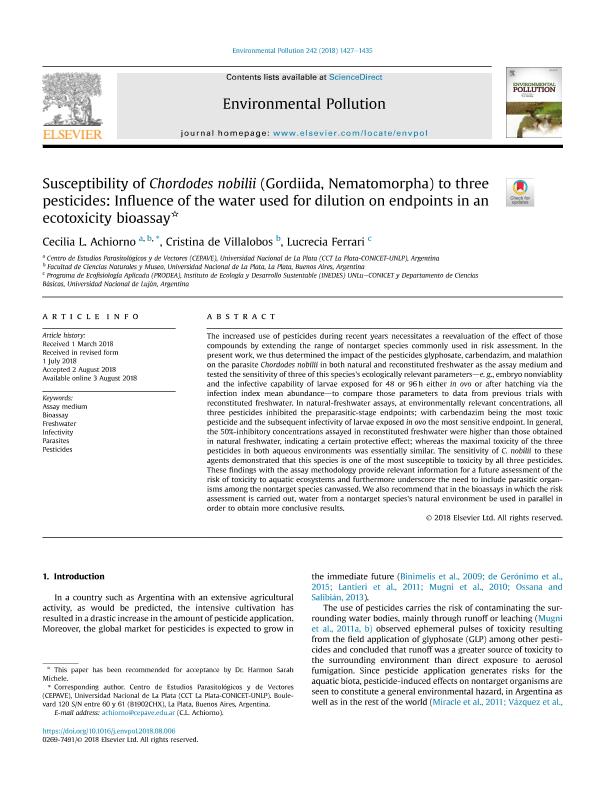Mostrar el registro sencillo del ítem
dc.contributor.author
Achiorno, Cecilia Lujan

dc.contributor.author
de Villalobos, Leonor Cristina

dc.contributor.author
Ferrari, Lucrecia

dc.date.available
2019-08-14T18:40:03Z
dc.date.issued
2018-11
dc.identifier.citation
Achiorno, Cecilia Lujan; de Villalobos, Leonor Cristina; Ferrari, Lucrecia; Susceptibility of Chordodes nobilii (Gordiida, Nematomorpha) to three pesticides: Influence of the water used for dilution on endpoints in an ecotoxicity bioassay; Elsevier; Environmental Pollution; 242; 11-2018; 1427-1435
dc.identifier.issn
0269-7491
dc.identifier.uri
http://hdl.handle.net/11336/81601
dc.description.abstract
The increased use of pesticides during recent years necessitates a reevaluation of the effect of those compounds by extending the range of nontarget species commonly used in risk assessment. In the present work, we thus determined the impact of the pesticides glyphosate, carbendazim, and malathion on the parasite Chordodes nobilii in both natural and reconstituted freshwater as the assay medium and tested the sensitivity of three of this species's ecologically relevant parameters—e. g., embryo nonviablity and the infective capability of larvae exposed for 48 or 96 h either in ovo or after hatching via the infection index mean abundance—to compare those parameters to data from previous trials with reconstituted freshwater. In natural-freshwater assays, at environmentally relevant concentrations, all three pesticides inhibited the preparasitic-stage endpoints; with carbendazim being the most toxic pesticide and the subsequent infectivity of larvae exposed in ovo the most sensitive endpoint. In general, the 50%-inhibitory concentrations assayed in reconstituted freshwater were higher than those obtained in natural freshwater, indicating a certain protective effect; whereas the maximal toxicity of the three pesticides in both aqueous environments was essentially similar. The sensitivity of C. nobilii to these agents demonstrated that this species is one of the most susceptible to toxicity by all three pesticides. These findings with the assay methodology provide relevant information for a future assessment of the risk of toxicity to aquatic ecosystems and furthermore underscore the need to include parasitic organisms among the nontarget species canvassed. We also recommend that in the bioassays in which the risk assessment is carried out, water from a nontarget species's natural environment be used in parallel in order to obtain more conclusive results. We underscore the necessity to include parasites among the biota bioassayed and also recommend the use of natural freshwater as the dilution medium in bioassays for the evaluation of pesticide ecotoxicity.
dc.format
application/pdf
dc.language.iso
eng
dc.publisher
Elsevier

dc.rights
info:eu-repo/semantics/openAccess
dc.rights.uri
https://creativecommons.org/licenses/by-nc-sa/2.5/ar/
dc.subject
Assay Medium
dc.subject
Bioassay
dc.subject
Freshwater
dc.subject
Infectivity
dc.subject
Parasites
dc.subject
Pesticides
dc.subject.classification
Otras Ciencias Biológicas

dc.subject.classification
Ciencias Biológicas

dc.subject.classification
CIENCIAS NATURALES Y EXACTAS

dc.title
Susceptibility of Chordodes nobilii (Gordiida, Nematomorpha) to three pesticides: Influence of the water used for dilution on endpoints in an ecotoxicity bioassay
dc.type
info:eu-repo/semantics/article
dc.type
info:ar-repo/semantics/artículo
dc.type
info:eu-repo/semantics/publishedVersion
dc.date.updated
2019-07-24T18:33:02Z
dc.journal.volume
242
dc.journal.pagination
1427-1435
dc.journal.pais
Países Bajos

dc.journal.ciudad
Amsterdam
dc.description.fil
Fil: Achiorno, Cecilia Lujan. Consejo Nacional de Investigaciones Científicas y Técnicas. Centro Científico Tecnológico Conicet - La Plata. Centro de Estudios Parasitológicos y de Vectores. Universidad Nacional de La Plata. Facultad de Ciencias Naturales y Museo. Centro de Estudios Parasitológicos y de Vectores; Argentina
dc.description.fil
Fil: de Villalobos, Leonor Cristina. Universidad Nacional de La Plata. Facultad de Ciencias Naturales y Museo; Argentina
dc.description.fil
Fil: Ferrari, Lucrecia. Universidad Nacional de Luján. Departamento de Ciencias Básicas. Programa de Ecofisiología Aplicada; Argentina. Universidad Nacional de Luján. Instituto de Ecología y Desarrollo Sustentable. Consejo Nacional de Investigaciones Científicas y Técnicas. Oficina de Coordinación Administrativa Parque Centenario. Instituto de Ecología y Desarrollo Sustentable; Argentina
dc.journal.title
Environmental Pollution

dc.relation.alternativeid
info:eu-repo/semantics/altIdentifier/url/https://www.sciencedirect.com/science/article/pii/S0269749118308947
dc.relation.alternativeid
info:eu-repo/semantics/altIdentifier/doi/http://dx.doi.org/10.1016/j.envpol.2018.08.006
Archivos asociados
